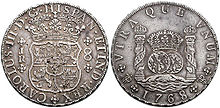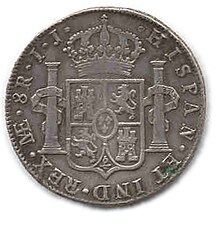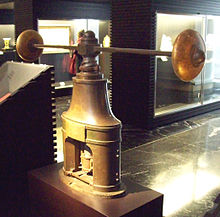Spanish coinage
Spanish coinage deals with the Spanish monetary system between the unification of the empire through the conquest of Granada and the discovery of America by Christopher Columbus in the same year until the loss of the American colonies (1820s). The quantities of precious metals - especially silver - that flowed from the New World to Europe and East Asia in the following centuries had far-reaching economic effects. The increase in the available amount of coin metal, which was obtained in America through slave labor, made general money transactions possible for the first time in Europe. The discovery of the amalgamation process for the separation of precious metals by Bartholomeus de Medina in 1557 was also of importance to almost 13: 1 since 1609, then 14: 1 as early as 1641, at the beginning of the 19th century 14.9: 1 to 15.5: 1 around 1870).
The expressions formed the basis for currencies whose names are still in use today. In the first 30 years after the conquest of Mexico (1519), no coins were minted in Spanish America; the metal, which had been roughly cleaned by smelting, was used by weight ( peso , as "mark" and ounces) until the 1560s . Although a lot of gold was found or plundered in New Granada (Colombia) in the 16th century , the value of the yield remained lower compared to the silver of the other colonies.
Maravedí
The maravedí was a common monetary unit in Spain and its possessions, the quality of which deteriorated progressively. For this reason, different qualities were distinguished in later times: de vellón, de plata antiqua and de plata mexicana.
From a Castilian marrow bronze ( vellón ) with (7/288 silver), according to the regulation of 1497, 192 blancas (1.2 g) were to be produced, with 2 blancas corresponding to one maravedi. The total was limited to 10 million blancas. In the time of Carlos I , the silver content was reduced to 11/576 in 1552. The next deterioration occurred in 1566 to 1/72 silver and 220 blanca per mark. In 1603 the silver was left out completely, a (new) maravedi was equated with a blanca of reduced weight (around 560 pieces / mark). This effective doubling of the copper price led to a shortage of gold and silver coins in Spain. The premium for silver soon reached 40%.
Castilian mark
In Spain, as everywhere at the beginning of modern times, a lot of foreign coins circulated. In addition, Aragon , Valencia and Catalonia had separate coins in the 16th century.
The old (legal) Castilian mark ( marco ) weighed 230.06 g . One in Medina del Campo issued Coinage ( Elogio ) Queen Isabella certain that Mark Gold (23.75 carats = 95/96 fine) worth 24,500 maravedis was to stamp out. It was divided into 50 castellanos as the unit of account; 1 Castellano, with 4.553 g of fine gold, corresponds to 490 maravedís. From the marrow silver (67/72 fine) 11⅙ dineros worth 2278 maravedis were to be minted . For the silver mark, there were 67 reales with 3.195 g of fine silver à 34 maravedís, which resulted in a legal value ratio of gold to silver of 10.114 to 1. From the Real which developed in the Arabian Riyal .
At this time, mostly half and whole reals were minted, but not yet larger pieces. As gold coin, 65⅓ ducats ( ducado, 95/98 fine, 3.495 g gold) were minted from one mark , so that it corresponded to the Venetian Zechine and the Hungarian ducat. The unit of account Castellano corresponded to 490 maravedís, the minted ducats to 375 maravedís, so there were around 11 silver reales for one gold ducat. In the colonies, Peso d'oro was used as a synonym for the Castellano. At the beginning of the Mexican and Peruvian silver mining (from 1546 in Potosí ) the point of reference was one silver mark equal to 5 Castellanos. The Mexican designation peso de minas (silver) related to the corresponding value of a peso de oro, equivalent to 13⅖ reales. In everyday use, contemporary literature names correspondences between 12 and 14 reals, which has to do with the inadequate possibilities of cleaning the silver. Gold coins became less and less common.
16th and 17th centuries
The increase in silver production led to the issue of larger silver coins, which were equivalent in value to ordinary gold pieces. The silver coin for 8 reales yielded, with the coin base unchanged, 8⅜ pieces per mark of coin silver, or 9 pieces per mark of fine silver. This corresponded to the German Reichstaler ( Joachimstaler , 9 pieces per Cologne mark of fine silver).
In 1537 a new gold coinage order was issued for Castile. Coronas i escudos should be minted in gold instead of Ducados . For the gold mark with 22 carats (i.e. 11/12 fine) there were 68 pieces worth 350 maravedis. The 2.9% heavier coins thus contained 4.6% less fine silver than before. The value of the escudo was increased to 400 maravedís in 1566. It was equivalent to 16 silver reales. At the same time, bronze coins (with 62/288 silver) were introduced, 80 of which were minted per mark - the equivalent of ¼ real.
From 1537 in Mexico and later in Peru, very raw, but manageable, "pieces of eight" (8 reales) made of silver were produced en masse. The taxation of precious metal extraction and the minting fee of three reals per mark were profitable for the crown. In the 16th century, anyone could bring metals to the mints for expression, but the remelting of coins and the export of bronze coins from Spain were forbidden. An export duty of 6% was levied on American silver.
Since 1642 there were also deteriorated reales de vellón, which were only half the value of the reales de plata . Due to the large volume of Vellón coins issued, gold and good silver coins were increasingly hoarded. The decree of October 14, 1686 led to a devaluation of silver compared to gold by ≈20% in the mother country ( plata nueva ). For the American colonies, the previous standard ( plata vieja ) remained. The new continental Spanish piece of eight was also known as peso sencillo .
Mexican dollar in Asia
From Mexico, large amounts of the silver extracted went to Manila in the annual convoy (1545–1813). Exact quantities are not known, but the galleon captured by Lord Anson in 1743 contained over 1.3 million pesos and a further 35,000 ounces of silver, which corresponded to over ten percent of Mexican annual production. The high level of acceptance is due to its convenience. Japan minted practically no coins of its own in the period before the closure . Silver was poured into small bars ("boats") and cut as needed. The Chinese tael , divided into 1,000 cash , had a different weight and purity in almost every province. As early as 1601, Elizabeth I had special coins (with portcullis ) minted for India based on the Spanish model in the Tower of London .
The coins with the characteristic "Pillars of Hercules" and the motto PLUS ULTRA, which were machine minted in Mexico since 1732, quickly spread as a universal trading coin. The real, partially rededicated with counterstamps, in Asia often referred to as “piastres,” “Spanish dollars” or “Mexican dollars” (M $), was - and remained until well into the 20th century - a generally accepted currency in Chinese culture.
The Mexican dollar was also the model for the Straits dollar (at 100 ¢), minted since 1845 , which, after its value had been stabilized by the fixed link to the gold-backed pound in 1906, became legal tender in the Straits Settlements , Federated Malay States and until 1912 was also in the Unfederated Malay States . Around this time it was ousted to Sumatra by the administration of the Dutch East Indies .
18th and 19th centuries
The coinage system issued in 1707, which remained in force until 1728, confirmed the provisions of 1497, according to which 8⅜ pesos at 8 reales were to be struck from the fine silver mark, i.e. 67 reales per mark 67/72 fine. When the coin base for silver pesos ( peso duro ) was reorganized , this was set at 8½ pieces per mark (131/144 fine). The value of these coins minted from 1732 was now 2½ reales de vellón (first minted as such in 1808) or 85 maravedís. In Spain, the minting of the silver real was stopped in 1837.
The law of May 29, 1772 caused a slight deterioration. For the silver mark there were 8½ pesos with a purity of 65/72. After independence, this standard was retained in Mexico. For gold minting it was determined in 1772 that 8½ quadruples or onzas de oro per mark of gold with a fineness of 43/48 were to be minted. The ratio of gold to silver on the basis of this law was 16 to 1. These deteriorated coins no longer show the columns of Hercules, but the bust of the Spanish king. In 1782 the first central bank was founded.
The Spanish-Mexican dollar and the equivalent coins of the South American states were legal tender in the USA until 1857. After their independence, the South American states soon switched to a coin base analogous to that of the French five-franc coin (22.5 g of fine silver), so that their currencies, under different names ( Peruvian Nuevo Sol , Boliviano , Chilean Peso , etc.), are reminiscent of the Latin Coin union leaned. When the pesete (Pta.) Was introduced in politically unstable Spain (1850/68), a real (de vellón) of a quarter of Pta. equated. The Banco de España has been a central bank since 1874.
See also
- Spanish real
- peso
- Spanish escudo
- Columnarios
- Price revolution
- Chinese currency
- List of exchange rates (gold standard)
literature
- Akira Motomura: The Best and Worst of Currencies: Seigniorage and Currency Policy in Spain, 1597-1650. In: Journal of Economic History. Vol. 54, No. 1, March 1994, pp. 104-127.
- Shepard Pond: The Spanish Dollar: The World's Most Famous Silver Coin. In: Bulletin of the Business Historical Society. Volume 15, No. 1, Feb 1941, pp. 12-16.
- Soetbeer: Precious metal production and the relationship between gold and silver. especially Appendix I: The older Spanish and Portuguese coinage ratios. In: E. Behm (Ed.): Dr. A. Petermann's communications from Justus' Perthes geographical institution. Supplementary Volume XIII (1879–1880).
Web links
Individual evidence
- ↑ Average life expectancy in the mines under 1 year. An estimated 8 million dead. see. Eduardo Galeano: Open Veins of Latin America: A History of the Potosi Mines in Bolivia: Discovery, Wealth, Slavery and Death in the Shadow of Cerro Rico. New York 1971. (Melbourne 2009, ISBN 978-1-921640-04-9 )
- ^ Henry R. Wagner: Documents on mining & Indians in Mexico. [Mexico, 1927-1938]
- ↑ Alexander von Humboldt in the Essai sur la Nouvelle-Espagne assumed 4714 kg for 1800. Quoted in Brehm (1880), p. 62.
- ↑ Printed: Covarruvias ; Veterum numismatum collatio cum his, quas expenduntur publica et regia autoritate percussa ;. In: Budelius, Cologne 1591 ( title reference VD16 ( page no longer available , search in web archives ) Info: The link was automatically marked as defective. Please check the link according to the instructions and then remove this notice. ); Reprinted as: Illustracion XX, Valor de las monedas que corrieron en Castillia durante el gobierno de la Reina Doña Isabel; Memorias de la Academia del la Historia, Madrid, T. VI (1821)
- ↑ Not counting that during the looting of Cuzco in 1535 (1102 kg of gold, 19 t of silver of various purity) and the Inca ransom of 1537 (11822 kg of silver, 5552 kg of gold) (calculated from the original documents still preserved in the Archivo de Indias ). Brehm (1880), p.
- ^ Charles V had been ruler of the Habsburg hereditary lands since 1506 and king of Spain since 1516.
- ↑ 1523-1529 and again from 1572-1820: 10%. Otherwise 20% on silver. Gold half a sentence. Behm (1880), p. 52.
- ↑ Behm (1880), p. 50.
- ↑ Edgar Thurston; Government Central Museum: History of the Coinage of the territories of the East India Company… Madras 1890, Pl. XVII.
- ↑ Colonial Milled (Pillar) Coinage 1732-1821: Introduction
- ↑ Fixed at £ 0/2/4, equivalent to 2.36 ℳ. List of exchange rates (gold standard)
- ↑ At this time Philip IV financed his household with paper money-like bonds, etc. In October 1710, these had to be exchanged for 5% shares, which had no market because of the financial situation in France, too. The richest banker at the time, Samuel Bernard , went bankrupt in 1714, followed by a general financial crisis. Alexander de Mar: History of monetary systems ;. London 1895, p. 453.
- ↑ The term duro was used in everyday Spanish until the introduction of the euro. He was referring to the 5 peseta coin .
- ↑ The Banco de España only got this name in 1856. It was called Banco de San Carlos until 1829 , then after a financial crisis Banco de San Fernando (Real cedula de SM el Rey Fernando VII, de 9 de Julio de 1829) and from 1847 Nuevo Banco Español de San Fernando. Earl Jay Hamilton: The Foundation of the Bank of Spain. In: Journal of Political Economy. Volume LIII (1945), p. 114.
- ^ A. Piatt Andrew: The End of the Mexican Dollar. In: Quarterly Journal of Economics. Volume 18, No. 3, May 1904, pp. 321-356.




